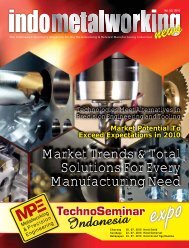High Speed Machining Precision Tooling - Indobiz.biz
High Speed Machining Precision Tooling - Indobiz.biz
High Speed Machining Precision Tooling - Indobiz.biz
Create successful ePaper yourself
Turn your PDF publications into a flip-book with our unique Google optimized e-Paper software.
• Part design can be based on<br />
function rather than manufacturing<br />
constraints.<br />
• Design changes can be implemented<br />
immediately at minimal cost.<br />
• Custom products can be produced to<br />
match customer requirements.<br />
DDM starts in design, with something like this CAD image<br />
of a jigsaw<br />
European countries, remain important<br />
clusters of RP innovation.<br />
What Is DDM?<br />
Direct digital manufacturing (DDM) is the<br />
process of using an additive fabrication<br />
system to create parts for end use. In<br />
fact, there is a growth in the number of<br />
manufacturers that are using additive<br />
fabrication systems to build a range<br />
of parts, such as components for new<br />
products, jigs, fi xtures, hand tools and<br />
gages. Design and engineering fi rms are<br />
fi nding further uses for fused deposition<br />
modeling (FDM) machines aside from<br />
the traditional rapid prototyping (RP)<br />
functionality.<br />
A variety of production materials can be<br />
used in the FDM process, including ABS,<br />
polycarbonates, polyphenylsulfones and<br />
blends. These materials allow users to<br />
manufacture parts that are tough enough<br />
for functional testing, installation, and<br />
most importantly, end use. Because<br />
thermoplastics are environmentally<br />
stable, their accuracy does not change<br />
with ambient conditions or time.<br />
Here are advantages for using DDM for<br />
manufacturing:<br />
• Complex parts can be produced<br />
without the need for highly skilled<br />
labor.<br />
• Parts can be produced as needed,<br />
eliminating the need for stock.<br />
Broadening The Scope<br />
The technologies that have dominated<br />
the industry since its inception continue<br />
to remain at the fore. These include<br />
stereolithography and the new Objet<br />
technology, which is a serious contender<br />
to the stereolithography’s historical<br />
crown. Fused Deposition Modeling<br />
(FDM) has also played a signifi cant role<br />
in the development of the industry and<br />
will continue to do so. Because of its<br />
varied material properties, FDM also<br />
plays a large role in the emerging DDM<br />
and rapid tooling markets, alongside<br />
technologies such as selective laser<br />
sintering.<br />
In terms of future use and adoption,<br />
price pressures persist across the<br />
industry as a whole. Profi tability lays<br />
in innovation and fi nding new ways to<br />
develop existing technologies.<br />
In the future, there probably will be more<br />
options in the palette and selection<br />
of materials. We are already using<br />
engineering plastics and materials in<br />
DDM works by compiling a 3D model from CAD data using<br />
an additive process. The machine lays layer after layer of<br />
material until the model is complete<br />
Shown is a production run of about 50 DDM parts (fl ag<br />
hold-downs), made for installation in its high-speed<br />
document scanning machines.<br />
machines and can use them in extremely<br />
high temperatures. For example,<br />
we develop DDM applications for<br />
automotive under-hood components—a<br />
concept practically unthinkable 20<br />
years ago.<br />
DDM and tooling in their limited formats<br />
are already here and are hot topics<br />
among media and industry experts. One<br />
of the most intriguing consequences of<br />
this increase is the potential to reverse<br />
the trend to outsource manufacturing<br />
to places like the Far East in order to<br />
avoid high labor and tooling costs. This<br />
trend could potentially be reversed if<br />
companies instead purchased the DDM<br />
machines of the future, which would<br />
give them a fi xed cost base, reduce<br />
labor intensity and remove high tooling<br />
costs and time, potentially negating the<br />
incentive to outsource. It would be great<br />
to see some manufacturing processes<br />
return to the developed economies.<br />
This brief “growth chart” of the RP<br />
industry is only a snapshot. The<br />
technology is moving so quickly that it is<br />
diffi cult to predict exactly where people’s<br />
ideas and needs will take it. It is up to<br />
the shops to ensure that we keep up<br />
with what customers require. We also<br />
need another shift in imagination as<br />
we once again encourage companies to<br />
raise their expectations. What is certain<br />
is that the results and applications will<br />
be astonishing and exciting, and we<br />
look forward to being at the forefront of<br />
taking the industry forward.<br />
indometalworking news Vol. 2 / 2008 33




